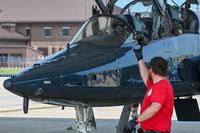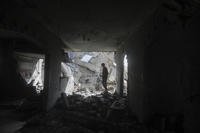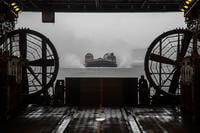The metaphorical C-27J battlefield has been mostly quiet since the skirmishes earlier this year over the Air Force's plan to mothball its entire fleet. For all intents and purposes, the fight seems to be settled.
Air Force leaders heard the objections of Congress and Guard and Reserve airmen, but they were glancing at their watches and checking their BlackBerries under the table the whole time. Since then, they have apparently gone ahead with the first steps toward icing the C-27Js even without outside buy-in, as Defense News' Marcus Weisgerber wrote this week.
On the real battlefield, however, far downrange in Afghanistan, the tale is different: An official Army story Monday, cited by Air Force Magazine's Daily Report, depicts a little twin-engined airlifter that could, winning fans among the grunts who, once upon a time, were to have been its primary users. Here was the word from Richard Barker of the 25th Combat Aviation Brigade:
Since beginning operations in August 2011, two C-27J aircraft have been tactically controlled by the 159th and 25th Combat Aviation Brigades. They have performed 67 airdrops and delivered more than 277 container delivery systems containing vital supplies such as food, water, blood and ammunition to special operations forces located in the unforgiving terrain of Afghanistan. The 25th CAB makes this support possible as a result of its solid understanding of soldiers' needs and its tactical control of the C-27J aircraft that are operated by the 702nd Expeditionary Airlift Squadron.
Got the setup? Air Force birds under the tactical command of Army aviation units, resupplying Army troops forward. OK, here we go:
Maj. Craig Jayson, executive officer for 3rd Battalion, 25th Aviation Regiment, 25th CAB, says with the C-27J relieving his unit's Chinooks, the unit has the opportunity to fly more missions to forward operating bases which the C-27J does not have access to."We can focus on picking up personnel and equipment that are lower priority and fulfill requests that are normally canceled due to lack of resources," said Jayson. "Overall, the C-27J increases our flexibility and ability to support more customers in a single day."
An increase in C-27J missions also decrease the costs associated with CH-47 missions as well.
"The hourly operational cost of a resupply mission using the Chinook is more than $7,500 an hour for the CH-47D and $9,000 an hour for the CH-47F," said Jayson.
Based off Landrum's calculations, the U.S. Army has saved $30 million by conducting missions with the C-27J instead of the CH-47 Chinook. When it comes to relieving the CH-47 Chinook with fixed wing assets, the C-27J seems to be the best choice over other fixed-wing options.
"The C-27J has all of the benefits of a fixed wing aircraft such as speed, altitude, payload capacity and range, yet also possesses the ability to conduct many mission sets similar to rotary winged cargo aircraft," said Sgt. Maj. Ronald Graves, 25th CAB operations sergeant major.
Adding to the list of the C-27J's benefits, Graves said the aircraft can operate in adverse weather and with limited visibility. Also the C-27J can land on a 2,400-foot dirt strip as opposed to the 3,000 feet a C-130 Hercules requires. Perhaps the biggest advantage the C-27J currently offers the Army is the fact it is tactically controlled by 25th CAB commander Col. Frank Tate. The tactical control gives him the flexibility to provide immediate support to soldiers on the battlefield.
"This relationship allows for quick and dynamic tasking, when required, which greatly increases our ability to deliver nearly anything, anywhere, in support of the soldier in the fight," said Graves.
Back to the metaphorical battlefield: These are shots across the Air Force's bow and it looks like the Army's gunners have their ranges dialed right in. The "customers" of the 25th CAB are loving their C-27Js, and this story even stacks them against the bird the Air Force says can do the job just as well: Its C-130 Hercules. Meanwhile, the Army saves money and wear by flying its Chinooks strategically, hitting the bases where the Spartans can't go.
Will this endorsement, from the very "warfighters" in whose name defense leaders always try to act, have any effect on the mothballization of the C-27Js? Probably not -- this is a truth vacuum, a reality-distortion zone, and unless the Spartan's allies in Congress unequivocally put their foot down, it looks like their ultimate departure remains certain.








